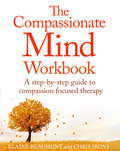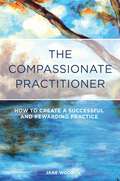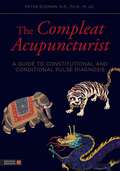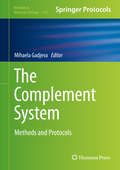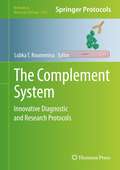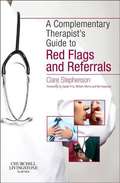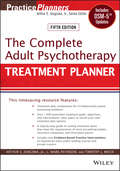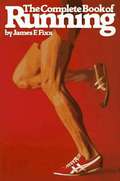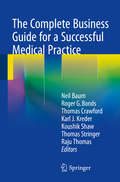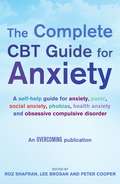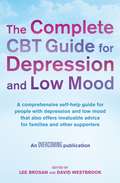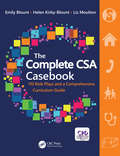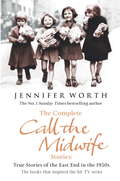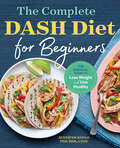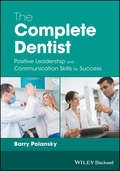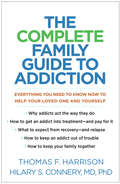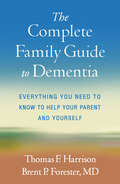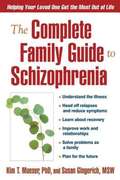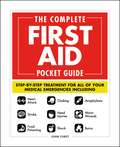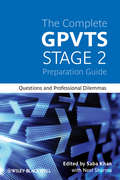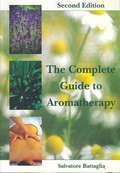- Table View
- List View
The Compassionate Mind Workbook: A step-by-step guide to developing your compassionate self
by Chris Irons Elaine BeaumontThere is good and increasing evidence that cultivating compassion for one's self and others can have a profound impact on our physiological, psychological and social processes. In contrast, concerns with inferiority, shame and self-criticism can have very negative impacts on these processes and are associated with poorer physical and mental health. The Compassionate Mind Workbook is for anyone who is interested in how compassion - in the form of ideas and practices derived from Compassion Focused Therapy (CFT) and other approaches - may help us to engage with, understand and ultimately, try to alleviate suffering. CFT utilises both Buddhist practices and Western psychological science. It draws on neuroscience, insights into emotion regulation and identity formation, interpersonal psychology and a range of psychotherapeutic models. CFT-based interventions can help people with a range of mental health problems develop compassion for themselves, be open to the compassion of others and develop compassion for others.This workbook is a step-by-step guide to CFT, in which the chapters build your understanding of yourself, the skills that give rise to a compassionate mind, and ways to work with whatever difficulties you're struggling with in life. The exercises, prompts and case stories in this book provide an understandable and practical way to develop compassion.
The Compassionate Practitioner: How to create a successful and rewarding practice
by Jane WoodFocusing on the importance of relationship-building, this handbook explains how to turn new clients into regulars and make your practice flourish. If you can create trust, loyalty and a sense of safety in new clients, they are more likely to commit to the further appointments needed to experience the healing you have to offer. This book considers how best to enhance the client's experience at every stage of the consultation through compassion and mindfulness. It is full of practical advice about everything from creating the right ambience in the therapy room to maintaining a positive attitude through self-reflection. This will be a valued support for students and professionals working in a wide range of complementary and alternative therapies, as well as art, music and drama therapists.
The Compleat Acupuncturist: A Guide to Constitutional and Conditional Pulse Diagnosis
by Peter Eckman William R. MorrisIn this highly original and authoritative book, Peter Eckman takes pulse diagnosis as a common thread that links and integrates the various disciplines of Oriental medicine, and shows that they are in fact related by a common origin several thousand years ago. The text describes the clinical details used in a variety of acupuncture styles, synthesizing them into a coherent whole, and illustrating the usefulness of this model with an extensive presentation of case histories. A fundamental premise of the book is that treatment should be based not only on the current condition of the patient, but even more importantly on their inherent constitution. The description of constitutional pulse diagnosis therefore forms Part 1 of the text, the description of conditional pulse diagnosis forms Part 2 and Part 3 provides more than 30 case histories with pulse analysis, diagnosis and treatment (with outcomes), so that the book will be of utmost practical benefit. Much of the book consists of new theoretical schemata to organize traditional Oriental medical concepts into a coherent whole - groundbreaking work that will provide fresh insights and deeper understanding to all practitioners of Chinese medicine, especially acupuncturists. It presents a wealth of material that is not commonly available in Indian (Ayurveda), Korean or Chinese medicine, as well as other traditions of Oriental medicine, including the only thorough presentation of Korean Constitutional Acupuncture in English, based on the author's personal study under its originator.
The Complement System
by Mihaela GadjevaComplement Systems: Methods and Protocolsis composed of32 individual chapters that describe a variety of protocols to purify and analyze the activity of the individual complement components or pathways. It includes assays that describe detection of complement SNPs, clinical methods to evaluate complement system activation and data interpretation. Written in the highly successfulMethods in Molecular Biology series format, chapters include introductions to their respective topics, lists of the necessary materials and reagents, step-by-step, readily reproducible laboratory protocols, and tips on troubleshooting and avoiding known pitfalls. Authoritative and practical, Complement Systems: Methods and Protocolsprovides acollection of well-established classical assays and recently developed new assays to analyze the complement system activation will be useful to a wide audience of scientists. "
The Complement System: Innovative Diagnostic and Research Protocols (Methods in Molecular Biology #2227)
by Lubka T. RoumeninaThis volume describes a range of methods used in complement laboratories and how to interpret the data. Chapters detail methods for depletion of IgG and IgM, quantification of complement proteins, C3dg quantification, complement C3 deposition on endothelial cells, anti-C1q auto-antibodies, and methods for assessment of interactions of proteins with heme. Written in the highly successful Methods in Molecular Biology series format, chapters include introductions to their respective topics, lists of the necessary materials and reagents, step-by-step, readily reproducible laboratory protocols, and tips on troubleshooting and avoiding known pitfalls. Cutting-edge and clearly written, The Complement System: Innovative Diagnostic and Research Protocols aims to ensure successful results in the further study of this vital field.
The Complementary Therapist's Guide to Red Flags and Referrals
by Clare StephensonOver the years in which I have been involved in the training of complementary medical practitioners, I have been struck by how frequently I have been consulted by students
The Complete Adult Psychotherapy Treatment Planner: Includes DSM-5 Updates
by L. Mark Peterson Timothy J. Bruce Arthur E. Jongsma Jr.A time-saving resource, fully revised to meet the changing needs of mental health professionals <P><P> The Complete Adult Psychotherapy Treatment Planner, Fifth Edition provides all the elements necessary to quickly and easily develop formal treatment plans that satisfy the demands of HMOs, managed care companies, third-party payors, and state and federal agencies. <P> New edition features empirically supported, evidence-based treatment interventions including anger control problems, low self-esteem, phobias, and social anxiety <P> Organized around 43 behaviorally based presenting problems, including depression, intimate relationship conflicts, chronic pain, anxiety, substance use, borderline personality, and more <P> Over 1,000 prewritten treatment goals, objectives, and interventions--plus space to record your own treatment plan options <P> Easy-to-use reference format helps locate treatment plan components by behavioral problem or DSM-5 diagnosis <P> Includes a sample treatment plan that conforms to the requirements of most third-party payors and accrediting agencies including CARF, The Joint Commission (TJC), COA, and the NCQA
The Complete Book of Essential Oils and Aromatherapy
by Valerie Ann WorwoodThis encyclopedic book contains, in practical and easy-to-understand form, every conceivable use for essential oils and aromatherapy in everyday life. The author, a practicing aromatherapist for more than twenty years, unlocks the power of essential oils in more than 600 original recipes, most needing only a few essential oils. Unlike over-the-counter products, the recipes you make yourself contain no harmful preservatives. Most basic needs can be covered with just ten essential oils.
The Complete Book of Running
by James F. FixxThe purposes of this book are, first, to introduce you to the extraordinary world of running, and second, to change your life. If you are not yet a runner, it will show you how to become healthier and happier than you have ever imagined you could be. It will do so no matter how out of shape or fat or old or ungraceful you are, and no matter how many times you have tried other exercise regimens and failed. With proper preparation and a few elementary precautions, practically anyone who can walk can run.
The Complete Business Guide for a Successful Medical Practice
by Raju Thomas Neil Baum Roger G. Bonds Thomas Crawford Karl J. Kreder Koushik Shaw Thomas StringerThis text provides physicians with the basic business skills in order for them to become involved in the financial aspect of their practices. The text will help the physician decide what kind of practice they would like to join (i. e. private practice, small group practice, solo practice, hospital employment, large group practice, academic medicine, or institutional\government practice) as well as understand the basics of contracting, restrictive covenants and how to navigate the road to partnership. Additional topics covered include, monthly balance sheets, productivity, overhead costs and profits, trend analysis and benchmarking. Finally, the book provides advice on advisors that doctors will need to help with the business of their professional and personal lives. These include accountants, bankers, lawyers, insurance agents and other financial advisors. The Complete Business Guide for a Successful Medical Practice provides a roadmap for physicians to be not only good clinical doctors but also good businessmen and businesswomen. It will help doctors make a difference in the lives of their patients as well as sound financial decisions for their practice.
The Complete CBT Guide for Anxiety
by Roz Shafran Lee Brosan Prof Peter CooperOvercoming app now available.A highly respectable and authoritative self-help guide on all the anxiety disorders: generalised anxiety disorder, health anxiety, panic, phobias, social anxiety, OCD.Edited by three leading CBT clinicians in the UK, this comprehensive guide offers individual CBT-based treatments for a wide range of anxiety problems. Each individual treatment reflects current the treatment in the UK for that anxiety disorder and is written by the clinician responsible for developing that treatment in the first place.Contributors include:Lars-Goran Ost (phobias)Dr Gillian Butler (social phobia - Gillian is the author of Overcoming Social Anxiety & Shyness) Anke Ehlers & Jennifer Wild (PTSD)Nick Grey & David M. Clark (panic disorder)Heather Hadjistavropoulos (health anxiety)Kevin Meares & Mark Freeston (Generalised Anxiety Disorder) Roz Shafran & Adam Radomsky (OCD)An ideal resource not only for those experiencing anxiety problems, but CBT therapists and IAPT workers.
The Complete CBT Guide for Depression and Low Mood: A Comprehensive Self-help Guide That Also Offers Invaluable Advice For Families And Other Supporters
by David Westbrook Lee BrosanOvercoming app now available.Depression and low mood affect a significant portion of the general public. Sadly, those with depression often experience other problems such as low self-esteem, relationship problems and sleeping problems. Cognitive Behavioural Therapy (CBT) is an extremely effective treatment for depression and low mood and is used widely in the NHS. The companion book to the popular Complete CBT Guide for Anxiety, this practical self-help book contains essential information about the nature of depression and covers a range of topics including insomnia, relationships, bipolar disorder and postnatal depression. It also provides information on some of the latest treatments such as Mindfulness, Behavioural Activation and Compassion-Focused Therapy. The chapters on individual techniques or problem areas are written by the leading experts in that field. Includes individual chapters on: Low self-esteem by Melanie Fennell Insomnia and sleep problems by Colin Espie Rumination by Ed Watkins Relationship problems by Donald Baucom Bipolar Disorder by Warren Mansell Depression in the elderly - Ken Laidlaw Postnatal Depression - Peter Cooper & Lynne Murray Depression and ill health - Stirling Moorey Behavioural Activation by David Richards Compassion - Paul Gilbert Mindfulness - Willem Kuyken & Halley Cohen Imagery - Ann Hackmann & Jon Wheatley
The Complete CSA Casebook: 110 Role Plays and a Comprehensive Curriculum Guide
by Liz Moulton Emily Blount Helen Kirby-BlountThis is the most comprehensive resource for candidates sitting the challenging final Clinical Skills Assessment exam, offering a complete curriculum guide as well as 110 role plays that can be removed and practised in pairs. The guidance is seamlessly aligned to the RCGP syllabus, fully up-to-date and referenced with the latest guidelines, with detailed 'model' answers to each case. Offering a new, straightforward consultation model highly suited to the requirements of the exam, the book provides: a realistic amount of information for both ‘doctor' and ‘patient’ to closely replicate the exam the answers! Each case includes a fully worked up ‘Model Consultation’ summaries of guidelines and tips from the authors' recent experience of the CSA exam for all 110 cases an easy way to mark each colleague’s role play attempts, with tick boxes on the Model Consultation and a universally applicable marking scheme card a colour-coded curriculum for ease of reference the only CSA casebook and revision guide providing information and answers across the curriculum. The Complete CSA Casebook is an excellent resource to prepare for a number of international examinations, including: Clinical Skills Assessment (CSA) for the RCGP (Royal College of General Practitioners). Simulated Surgery, Learning Needs Assessment, for the International GP Recruitment (IGPR) Scheme, GP Returner Scheme and GP Induction Scheme. Objective Structured Clinical Examination (OSCE) for the RACGP (Royal Australian College of General Practitioners) Fellowship. GPEP1 Clinical Examination for the RNZCGP (Royal New Zealand college of General Practitioners). The Certification Examination in Family Medicine simulated office orals (SOOs) for The College of Family Physicians of Canada." The Family Medicine Certification Examination for the ABFM (American Board of Family Medicine). and will remain an invaluable resource for best general practice after qualification.
The Complete Call the Midwife Stories: True Stories of the East End in the 1950s
by Jennifer WorthThe East-End stories that inspired the BBC TV series, CALL THE MIDWIFE, in a gorgeous gift box.London's East End in the 1950s was a tough place: the struggles of post-war life - bombsites, overcrowded tenements, crime, brothels - bred a culture of tight-knit family communities, larger-than-life characters and a lively social scene. It was into this world that Jennifer Worth entered as a trainee midwife. But docklands life was tough, and babies were often born in slum conditions.In funny, disturbing and heartbreaking stories, Jennifer Worth recounts her time among nuns, prostitutes, abortionists, bigamists, gangsters and expectant mothers, portraying East Enders' amazing resilience - and their warmth and humour in the face of hardship. Written with affection and nostalgia, her midwife stories chronicle the lives, traditions and tales of a bygone era.
The Complete DASH Diet for Beginners: The Essential Guide to Lose Weight and Live Healthy
by Jennifer Koslo RNDGo DASH in a flash—a meal plan for getting started with the DASH dietLooking for a diet that will improve your health, help you lose weight, and isn't too restrictive or complicated? Then The Complete DASH Diet for Beginners is just what the dietician ordered. Not only does this cookbook fully explain how and why the DASH diet works, it also makes starting out as simple as can be.Two complete meals plans—plus a quick guide for familiarizing yourself with DASH diet basics—make beginning your new diet easy. The Complete DASH Diet for Beginners also provides you with 75 mouthwatering (and heart-healthy) recipes, including Southwest Tofu Scramble, Balsamic-Roasted Chicken Breasts, and Pan-Seared Scallops.The Complete DASH Diet for Beginners includes:Go DASH in 5 steps—Start your new diet right with advice for tossing non-DASH foods, shopping smarter, setting up your kitchen, planning meals, and getting fit and active.2 week-long meal plans—It's easy to eat right with meal plans—shopping lists included—that will take you from breakfast to dinner for an entire week.75 simple, tasty recipes—From Strawberry Yogurt Smoothies and Loaded Baked Sweet Potatoes to Honey-Mustard Chicken and Steak Tacos, discover healthy foods you'll absolutely love.Hit the ground running on your new diet thanks to The Complete Dash Diet for Beginners.
The Complete Dentist: Positive Leadership And Communication Skills For Success
by Barry PolanskyThe Complete Dentist: Positive Leadership and Communication Skills for Success is a one-of-a-kind guide to starting and running an effective and successful dental practice. Presents tried-and-true ideas and methods for effective communication, blending positive psychology with leadership in dentistry Describes the five elements of success and happiness, offering pathways to a flourishing dental practice Considers the reasons why communication and leadership skills are important for dentists
The Complete Encyclopedia Of Natural Healing: A Comprehensive A-Z Listing of Common and Chronic Illnesses and Their Proven Natural Treatments
by Gary NullThe first revision of this bestselling book since 1998 contains the latest findings in top health concerns, including cancer, stroke, heart disease, and hormone replacement therapy.
The Complete Family Guide to Addiction: Everything You Need to Know Now to Help Your Loved One and Yourself
by Thomas F. Harrison Hilary S. ConneryIf you are struggling to help a loved one recover from addiction--and to cope with the devastating impact on the whole family--you are not alone. But until now, there has been no single book that gives the millions of families like yours the comprehensive, unbiased information you need. This expertly written guide addresses the painful questions that spouses, parents, and grown children face every day. Why do addicts make such bad choices? How can you find (and afford) treatment that works--and convince your loved one to try it? Can relapse be prevented? When does being supportive cross the line to enabling? Providing science-based answers and resources, the authors cover crucial emotional, financial, and legal issues that simply aren't discussed in other books. The more your family knows about the myths and realities of addiction, the better equipped you will be to overcome it.
The Complete Family Guide to Dementia: Everything You Need to Know to Help Your Parent and Yourself
by Brent P. Forester Thomas F. HarrisonIf you are facing the unique challenges of caring for a parent with dementia, you are not alone. What do you do when your loved one so plainly needs assistance, but is confused, angry, or resistant to your help? Where can you find the vital information you need, when you need it? Journalist Thomas Harrison and leading geriatric psychiatrist Brent Forester show that you don&’t have to be a medical expert to be a good care provider in this authoritative guide. They explain the basics of dementia and offer effective strategies for coping with the medical, emotional, and financial toll. With the right skills, you can navigate changing family roles, communicate better with your parent, keep him or her safe, and manage difficult behaviors. Learn how to "care smarter, not harder"--and help your loved one maintain the best possible quality of life.
The Complete Family Guide to Schizophrenia
by Susan Gingerich Kim T. MueserWill the person you love ever get better? Chances are you've grappled with the question. With care and support from their families, people with schizophrenia can and do make vast improvements. Noted therapists Kim Mueser and Susan Gingerich deepen your understanding of the illness and cover a wide range of effective treatments. Based on decades of research and experience, they offer pragmatic suggestions for dealing with depression, psychosis, and other symptoms. They show you how to prioritize needs, resolve everyday problems, and encourage your loved one to set life goals. Plus, individual sections highlight special issues for parents, children, siblings, and partners. Whether you're facing schizophrenia for the first time or you've dealt with its impact for years, you'll discover innovative ways to handle challenges that arise over the course of treatment, from reducing the chances of relapse to making friends and finding work. Recovery isn't an endpoint--it's a lifelong journey. With love, hope, and realistic optimism, striving for it can lead to a richer, more rewarding life for your entire family. Winner, NAMI/Ken Book Award
The Complete Family Guide to Schizophrenia: Helping Your Loved One Get the Most Out of Life
by Kim Mueser Susan GingerichWill the person you love ever get better? Chances are you've grappled with the question. With care and support from their families, people with schizophrenia can and do make vast improvements. Noted therapists Kim Mueser and Susan Gingerich deepen your understanding of the illness and cover a wide range of effective treatments. Based on decades of research and experience, they offer pragmatic suggestions for dealing with depression, psychosis, and other symptoms. They show you how to prioritize needs, resolve everyday problems, and encourage your loved one to set life goals. Plus, individual sections highlight special issues for parents, children, siblings, and partners. Whether you're facing schizophrenia for the first time or you've dealt with its impact for years, you'll discover innovative ways to handle challenges that arise over the course of treatment, from reducing the chances of relapse to making friends and finding work. Recovery isn't an endpoint--it's a lifelong journey. With love, hope, and realistic optimism, striving for it can lead to a richer, more rewarding life for your entire family.
The Complete First Aid Pocket Guide: Step-by-Step Treatment for All of Your Medical Emergencies Including • Heart Attack • Stroke • Food Poisoning • Choking • Head Injuries • Shock • Anaphylaxis • Minor Wounds • Burns
by John FurstFrom minor cuts and burns, to heart attacks and strokes, this handy, take-anywhere guide gives you the knowledge and advice you need to recognize and respond to any medical emergency.Be prepared for any medical emergency and handle it safely and efficiently with The Complete First Aid Pocket Guide. Quickly identify signs and symptoms of a wide range of medical conditions andlearn how to recognize the difference between a minor injury or illness, and those that are more serious with this essential handbook. Each section of The Complete First Aid Pocket Guide includes a quick list of signs and symptoms to look for and step-by-step first aid instructions for dealing with each situation, all in user-friendly, simple language that&’s easy to understand. Medical issues covered include: —First aid basics, including roles and responsibilities of a first aider, managing an incident, activating emergency services, and infection control —Lifesaving skills including the recovery position, cardiopulmonary resuscitation (CPR), and use of an automated external defibrillator (AED) —Minor injuries and conditions, including soft tissue injuries, splinters, blisters, eye injuries, nosebleed, diarrhea, and vomiting —Traumatic injuries including severe bleeding, amputation, shock, fractures, crush injuries, burns, and head and neck injuries —Medical emergencies including heart attack, stroke, asthma, anaphylaxis, hypoglycemia, meningitis, seizures, poisoning, and emergency childbirth —Environmental conditions including hypothermia, frostbite, heat stroke, sunburn, and lightning strike —Pediatric emergencies and illnesses, including assessing an unresponsive child or baby, pediatric cardiopulmonary resuscitation (CPR), choking, croup, and febrile seizures —First aid kit lists for home, vehicles, and outdoor use With an appendix featuring an A-to-Z list of every condition covered, it&’s easy for you to quickly find the exact information you need in any situation you may face. With its small trim and portable size, The Complete First Aid Pocket Guide is the perfect addition to a home first aid kit, car first aid kit, disaster-survival bag, as well as a pocket companion for EMTs and other first responders in the field.
The Complete GPVTS Stage 2 Preparation Guide: Questions and Professional Dilemmas
by Saba Khan Neel SharmaEase the pressure of the GP Vocational Training Scheme Stage 2 exams, and ensure your progress to Stage 3, with this complete preparation guide Featuring all question types from the exam, including SBAs, EMQs and Professional Dilemmas, and covering a range of medical and surgical specialties, this invaluable guide not only tests appropriate application of clinical knowledge, but encourages doctors to think logically and ethically - vital in recognising appropriate behaviour in professional dilemmas. The opening section provides handy advice on how to prepare for the exam and explains what the question setters are looking for - the key to success in Stage 2. Based on the contributors’ own experience of typical problems and dilemmas, and including thorough explanations for each answer, this book is not just an exam crammer, but a valuable learning tool.
The Complete Guide to Aromatherapy
by Salvatore BattagliaA wide-ranging guide to aromatherapy, including units on its background, essential issues, remedies, practical matters, clinical index, aesthetic aromatherapy, 8 appendices and 2 indices.
